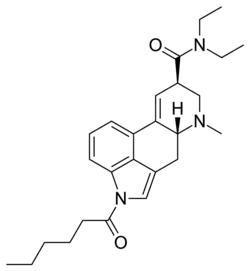1H-LSD
 | |
| Legal status | |
|---|---|
| Legal status |
|
| Identifiers | |
| |
| PubChem CID | |
| Chemical and physical data | |
| Formula | C26H35N3O2 |
| Molar mass | 421.585 g·mol−1 |
| 3D model (JSmol) | |
| |
| |
1H-LSD (N1-hexanoyl-lysergic acid diethylamide, SYN-L-027)[1] is an acylated derivative of lysergic acid diethylamide (LSD), with a six carbon hexanoyl chain attached to the N1 position. It acts as a prodrug for LSD, and in animal studies produces drug-appropriate responding with a similar potency to short-chain homologues such as ALD-52 and 1P-LSD, in contrast to the 4 and 5 carbon homologues 1B-LSD and 1V-LSD which are several times weaker.[2]
Structure
Pharmacology
Effects
1H-LSD produces similar effects to LSD with a shorter metabolic half-life. There are no documented cases of it being used recreationally.[3]
See also
References
- ^ WO 2024028495, Stratford A, Williamson JP, "Prodrugs of Substituted Ergolines", published 8 February 2024, assigned to Synex Holdings BV
- ^ Brandt SD, Kavanagh PV, Gare S, Stratford A, Halberstadt AL (July 2024). "Analytical and behavioral characterization of 1-hexanoyl-LSD (1H-LSD)" (PDF). Drug Testing and Analysis. doi:10.1002/dta.3767. PMID 38965834.
- ^ Brandt SD, Kavanagh PV, Gare S, Stratford A, Halberstadt AL (April 2025). "Analytical and behavioral characterization of 1-hexanoyl-LSD (1H-LSD)". Drug Testing and Analysis. 17 (4): 561–569. doi:10.1002/dta.3767. PMC 11994379. PMID 38965834.
| Ergolines (incl. lysergines) |
|
|---|---|
| Clavines (6,8-dimethylergolines) |
|
| Lysergamides (lysergic acid amides) |
|
| Ergopeptines (peptide ergolines) |
|
| Partial ergolines |
|
| Related compounds | |
| Natural sources |
|
| |
This article is issued from Wikipedia. The text is available under Creative Commons Attribution-Share Alike 4.0 unless otherwise noted. Additional terms may apply for the media files.